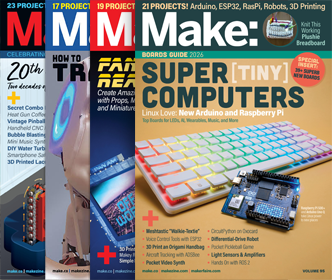Interview with Ben Heck – Console Hacker Extraordinaire
 Great interview! “Benjamin Heckendorn (aka Ben Heck) is one of the greatest console hackers the gaming community has ever known. Not only does Ben have the amazing technical knowledge and great design sense, but he is also a riot to converse with. In case you are not familiar with his work, Ben basically takes full game systems (from basically all console generations) and turns them into a custom handheld device.” Thanks Brian! Link.
Great interview! “Benjamin Heckendorn (aka Ben Heck) is one of the greatest console hackers the gaming community has ever known. Not only does Ben have the amazing technical knowledge and great design sense, but he is also a riot to converse with. In case you are not familiar with his work, Ben basically takes full game systems (from basically all console generations) and turns them into a custom handheld device.” Thanks Brian! Link.




 Raphael writes “In order to practise at the arcade version of Super Mario Bros, I modified a NES to be able to run arcade ROMs. The result: A dedicated Super Mario Bros VS. console with switches on the front panel to tweak some aspects of the game (A user friendly version of dip switches found on the arcade motherboard).”
Raphael writes “In order to practise at the arcade version of Super Mario Bros, I modified a NES to be able to run arcade ROMs. The result: A dedicated Super Mario Bros VS. console with switches on the front panel to tweak some aspects of the game (A user friendly version of dip switches found on the arcade motherboard).” 
 Heyrocker writes “This is a coffee table built from the playfield of a pinball machine. It is pretty easy to build and best of all, it lights up! It was inspired by a bar in Seattle called Shorty’s, which has tables similar to these in its booths.” Complete how-to on Instructables!
Heyrocker writes “This is a coffee table built from the playfield of a pinball machine. It is pretty easy to build and best of all, it lights up! It was inspired by a bar in Seattle called Shorty’s, which has tables similar to these in its booths.” Complete how-to on Instructables! 
 Excellent guide on replacing capacitors in old radios “Second only to power cords, capacitors are the most failure-prone components in old radios. In a professional overhaul, it is common to replace all of a radio’s large electrolytic capacitors and small paper capacitors. This article explains how to do just that. In many cases, this “recapping” is all that the radio needs to be restored to health.”
Excellent guide on replacing capacitors in old radios “Second only to power cords, capacitors are the most failure-prone components in old radios. In a professional overhaul, it is common to replace all of a radio’s large electrolytic capacitors and small paper capacitors. This article explains how to do just that. In many cases, this “recapping” is all that the radio needs to be restored to health.” 
 Paul from Dotmatrixsynth makes musical instruments out of printers, here writes – “I’ve got an ongoing project, reprogramming the firmware in these 1985 Epson LQ-500 printers to turn them into musical instruments. I originally just wanted to make a sort of homemade mellotron, but it’s evolved into a much deeper project. These printers (like all printers) have a computer inside that operates all the motors and handles the parallel port, etc. The software that drives that computer is all on an EPROM (a reprogrammable ROM chip.) I remove the EPROM, erase it, and reprogram it with my own software that I’ve developed by reverse engineering the printer and its computer.”
Paul from Dotmatrixsynth makes musical instruments out of printers, here writes – “I’ve got an ongoing project, reprogramming the firmware in these 1985 Epson LQ-500 printers to turn them into musical instruments. I originally just wanted to make a sort of homemade mellotron, but it’s evolved into a much deeper project. These printers (like all printers) have a computer inside that operates all the motors and handles the parallel port, etc. The software that drives that computer is all on an EPROM (a reprogrammable ROM chip.) I remove the EPROM, erase it, and reprogram it with my own software that I’ve developed by reverse engineering the printer and its computer.” 
 Adam Tow writes “The big news coming out of the
Adam Tow writes “The big news coming out of the 
 Dennis on the Amiga forums is building a mini Amiga. He writes – “I bought a Spartan-3 FGPA development board, learned Verilog (after finding out that VHDL was not my cup of tea) and started working on Minimig. Minimig stands for (very originally ) mini Amiga. My aim with Minimig is to built a complete OCS A500 (with some extra grunt and features like 4Mbyte ram and fast 68000 processor) on a circuit board about the size of a floppy drive. Loading of programs will be done by means of a MMC flash card, which holds the .ADF images of the floppies like a sort of hardware UAE!” [
Dennis on the Amiga forums is building a mini Amiga. He writes – “I bought a Spartan-3 FGPA development board, learned Verilog (after finding out that VHDL was not my cup of tea) and started working on Minimig. Minimig stands for (very originally ) mini Amiga. My aim with Minimig is to built a complete OCS A500 (with some extra grunt and features like 4Mbyte ram and fast 68000 processor) on a circuit board about the size of a floppy drive. Loading of programs will be done by means of a MMC flash card, which holds the .ADF images of the floppies like a sort of hardware UAE!” [